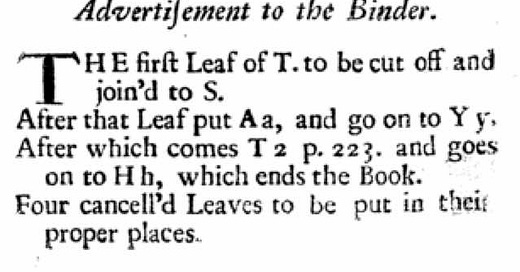In volume 3 of Laurence Sterne’s The Life and Opinions of Tristram Shandy, Gentleman (1761), Tristram famously presents the reader with a marbled page to stand as ‘motley emblem of my work’: an image that, with its swirls and loops, defies interpretation, and also, crucially, is different in every book. Printing may offer the promise of duplication – of each copy in an edition being the same – but every hand-made marbled page in Tristram Shandy is necessarily distinct: the printed iteration converted back, spectacularly, into a unique object. Here is the marbled page in one copy, held by the Laurence Sterne Trust at Sterne’s old home, Shandy Hall, in Coxwold (which, by the way, if you haven’t visited, then you must, from May 28th).
In the first edition of Tristram Shandy, the marbled page for each of the 4,000 (or so) copies seems to have been created by folding the margins of the page and then dipping both sides in marbling ink, and then hand-stamping the page number.1 What a labour!2 In some copies of later editions, the marbled page was never added but the unfulfilled instructions to the binder remain visible. Here is one such moment of bibliographical breakdown in an 1803 copy I bought cheap because it was missing the title-page:
The book production process, normally tidied up and hidden away in the finished copy, is suddenly visible, and we see the labour that went into the making (or should have done): the pounding legs beneath the graceful swan’s glide.
Instructions to binders were normally conveyed verbally, or on pieces of paper separate from the book, but sometimes they were included in blank spaces within the book and remain visible, like an accidental remnant or a note that was never crossed out. They are a quiet refrain in a number of hand-press books, particularly when the process of binding was complicated – by plates that needing inserting, for example, or odd page orderings, or leaves requiring cancellation and replacement.3 In Thomas Mills’ The history of the holy war began anno 1095, by the Christian princes of Europe against the Turks, for the recovery of the Holy land (1685), the instructions follow a list of errors prompted ‘by the absence of the Author from the Press’: what the print shop has produced is an almost-but-not-quite completed book, and reader and binder are required to finish things off.
Here are instructions for the insertion of tables and ‘Two Pedegrees of Kings’ that appear in James Tyrell’s General History of England (1696), amid some nasty bleed-through from the over-inked index on the other side of the leaf:
Prescriptions are often quite vague on the technical niceties, cheerily devolving responsibility down onto the binder’s competence. Henry Briggs’ Tabulæ logarithmicæ (1663), for example, includes a table of decimals that should fold out from the edge of the book: ‘Place this Table at the end of the Booke,’ the binder is instructed, ‘in such sort that it being unfolded may appeare quite without the leaues of the booke, when the rest of the booke is shut.’ (In the Bodleian Library’s copy, Savile H. 19, the table has been bound in this way.) Other instructions can get fairly baroque. The following survives as a fragment at the British Library, cut from an unidentified edition of John Speed’s The Theatre of the Empire of Great Britaine (1610-32):
And this one included at the very end of William Turner’s A compleat history of the most remarkable providences both of judgment and mercy (1697), published by John Dunton, is even more detailed:
The sense on reading these bits of text – not intended for our eyes – is of a book as a pile of sections that need ordering, arrangement, placement, joining together, like B.S. Johnson’s The Unfortunates (1969), but 300 years earlier. What makes the Tristram Shandy example distinct is that Sterne’s novel is the great work of literary self-reflexivity: the novel shows how it is built – as, for example, in the diagrams that map the non-linear, digressive paths a story might take.
We are not meant to see these instructions to the book-binder, but in a novel that reveals its workings, the status of these directions becomes complicated – swept up, as they are, within the broader movement of a book turning itself inside out. Is this unfulfilled command to the binder not only a failure of production, but also one other instance of the book converting its materiality into literary effect, like the black page that mourns Parson Yorick’s death, or the ‘chasm of ten pages’ where Tristram has ‘torn out’ a chapter? And if the marbled page interrupts our reading experience, then why not be doubly interrupted by the instructions to the binder to create that marbled page? One achievement of Sterne is to establish an attitude towards the book in which there is no outside that is not drawn into its centripetal wit: no sturdy ground of book production which precedes literary art, of paratext which remains distinct from text.
Helen Williams, Laurence Sterne and the Eighteenth-Century Book (Cambridge University Press, 2021), p. 28. I’ve not yet read this book beyond a quick Google search but it looks fantastic.
B. J. McMullin, ‘Printers’ Instructions to Binders’, in The Papers of the Bibliographical Society of America Vol. 104, No. 1 (March 2010), 77-104 (78).










Wondering if there are any written records of binder's responses to these sort of vexing demands made upon their skill and time? They were the economically abject members of 18th century letterpress ecology, and according to James Raven 'Very few were were able to afford election to the Company livery. The lives and careers of most are consigned to oblivion.'